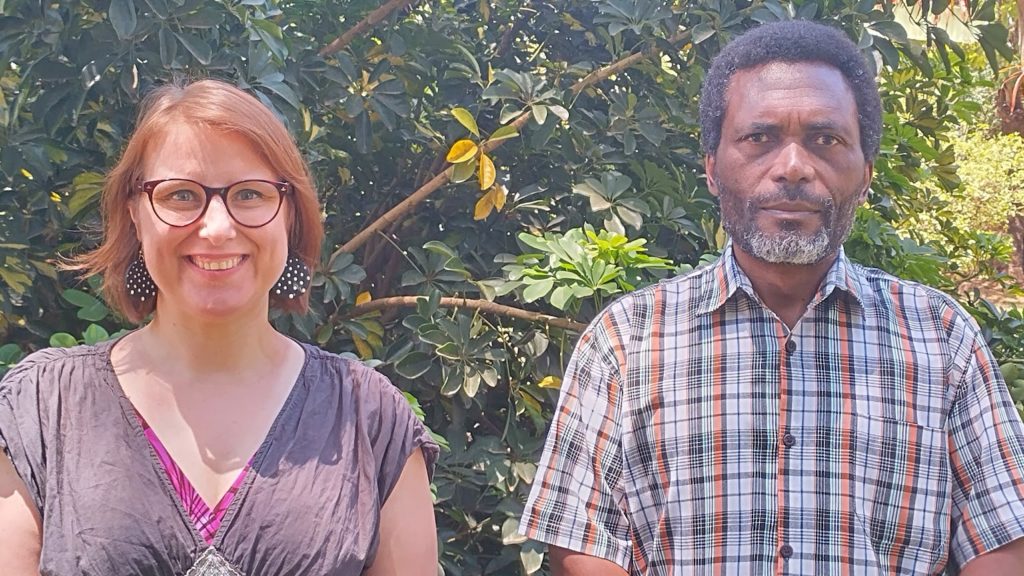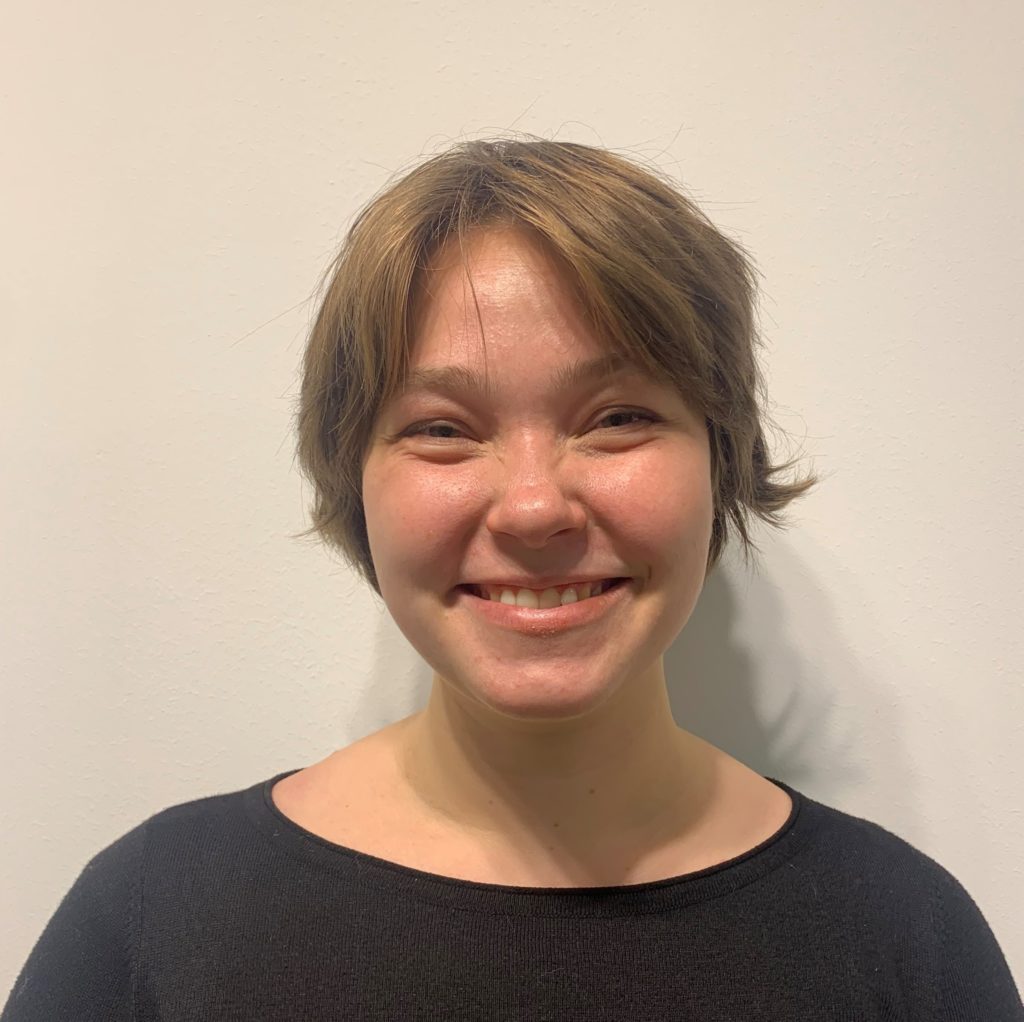The future of students
By zooming in on the student perspective, Hanna’s research engages with the starting point of learning – the learner. Hanna has been doing so through a longitudinal study that began in 2005 and which takes the exceptional approach of collecting drawings from students from a variety of countries over time. The countries from which her data originates are Tanzania, Finland, the UK, India, and Ghana, with most of the collection having taken place in Tanzania and Finland.

What is especially exceptional about Hanna’s research is the method itself. In her research, Hanna asks the students to draw themselves the way they imagine themselves at the age of 40. She first asked this question of a group of 9-year-old students in Tanzania and Finland in the 2005-2006 period, and in so doing gathered a series of drawings from these children which she would keep for decades after. She then continued to visit the same group of children again and again every three years to collect more drawings, mapping the progress of the children’s growth over time in terms of not only imagination and drawing skills but also dreams and, especially remarkably, the children’s mental state at the point of drawing. The children Hanna met back then have now grown up – they range from about 25 to 28 years old. Hanna has met many of them again in Tanzania and in Finland at this age.
This is the starting point of Hanna’s research: she believes the way a child imagines their future in twenty to thirty years tells a lot about their state of being when they draw that image. Hanna explains how one 15-year-old student refused to do the assignment at all because she wouldn’t get a grade for it, saying that “if [she doesn’t] get into the university [she wants to] after high school, then there’s no future for [her] anyway”. Such observations give clear insights into the values and wellbeing of a student as well as show the underlying power of the project itself: to check in with students in a creative, open-ended way.
Collecting futures
Although there have been art exhibitions on the topic, research on children’s dreams of the future has not or at least rarely been done. For Hanna, her work on this topic began during her master’s studies, to be continued into her PhD and beyond. Of course, what makes the project so special is its longitudinal nature – a type of study that is difficult to achieve and, perhaps also because of its consequent rarity, frequently bears very interesting results. Additionally, Hanna stresses the advantages of her method – especially the way this study allows for relatively cheap and easy data collection from children.
Hanna’s study allows her to compare observations about children’s views on the future as well as well-being both over time and cross-culturally. Because of the large number of groups and the fact that it is not always easy to catch every student after school, Hanna did not visit every single student after the first session(s). Still, Hanna was able to visit the group of students she started with in Finland and Tanzania in 2005 every three years, nonetheless allowing for a longitudinal analysis. Her number of research participants totals at an impressive count of 509 students interviewed by 2017, 13 of which were analysed longitudinally. In the 2022–2023 period, Hanna is continuing with 26 (13 Tanzanian + 13 Finnish) longitudinal analyses. In addition, altogether about 80 new students (from both countries) of approximately 15 years old have drawn their drawings for Hanna to be able to compare whether there has been a general change in the visions of people of this age in the decade.
Image (right): Hanna Lampi in Tanzania, 2023, posing with a tree she planted there in 2008.

Hanna has always presented the assignment to her subjects in their own school language and has used an interpreter to help her. In Tanzania, the language of instruction is Swahili for primary school and English for secondary school. Hanna visited the Tanzanian children in primary school in 2005 (when they were around 9-11 years old), in 2008, and then in secondary school in 2011. Finally, she visited them again in February 2023, when she met them as adults. As for the Finnish group (9-, 12- and 15-year-olds), Hanna is well aware in her research that there is variation between her research subjects: Finnish children are not necessarily always descendants of generations born and raised in Finland, which, she notes, makes life-span research very interesting.
The instructions they received each time were simple: Imagine yourself as an adult of about 40 years old and draw a picture of or – as an option for 15-year-olds and adults – make a mindmap for your imagined future. The drawing or mindmap needs to include at least the student (as an adult), their home, the people around them, and any animals who are living with them. Hanna notes that she specifically did not mention family because she did not want to plant any seeds that would suggest a family was a necessary part of the children’s futures. She then also asked the students to write the location (village, city, country) they imagine this future taking place in, and what their job and hobbies will be. The 15-year-olds were finally also asked if they had any personal values they wanted to mention.
In explaining her research, Hanna does not mention the term “dream” directly – the future the students are asked to draw is their imagined future, not their dream future. However, due to the openness of their futures, she suggests that many children do map out their dreams – or at the very least where they hope to be at the age of 40.
Students on their own futures
As in the case of the student who worried her grades and university acceptance would define the rest of her life, Hanna’s interviews reveal a lot about the extent of the angst some students experience about their futures. Hanna elaborates how the largest share of negative answers came from Finnish students, either in their not taking the task seriously at all – which, she notes, can also reveal a certain fear of considering the future – or, in rare cases, extreme negativity about the future itself. One student said she simply could not imagine a future; Hanna has now interviewed her as an adult and gotten the full explanation for her previous feelings.
In the task, the children focused on their own futures and those of their direct environments; not on the future of the world at large as much. For instance, only a few of the children drew science-fictionally imaginative elements such as advanced robotry. Considering society at large seems to be more of an activity for adults, Hanna says.

Reactions to the task itself also reveal a lot. Hanna shares how most kids have been extremely motivated and excited, and especially as adults. At the later ages, they have become very grateful that she has kept all their childhood drawings and they have strongly encouraged her to contact them about the project whenever she wants.
What the students seemed to love the most was the fact that, as Hanna puts it herself, the study allows them to reconnect with their younger selves and envision their lives from a very different perspective than they otherwise would have. Because Hanna saved all the drawings and brought them with her when visiting the group of Tanzanian ‘kids’ (now adults) she initially visited in 2005, they got to see how quite a few of them managed to realise their dreams before they even reached the age of 40. One student had wanted to be a lorry driver and is now doing just that, being surprised at seeing his own drawing from 18 years before and the accuracy of the situation he had drawn back then compared to his life now. Another had wanted to be a tourist guide and completely forgotten that dream until Hanna showed him his drawings as an adult, during which time he was working as a safari driver. It took Hanna’s explicitly pointing out how similar the two jobs were for him to realise he was living his childhood dream. Hanna asked the now-25-year-olds to draw their imagined futures at 40 again at this age and hopes to still visit them as time progresses.
Imagined futures across the globe
Hanna’s dissertation revealed some patterns when comparing the drawings cross-nationally. Finnish nine-year-olds, for instance, frequently imagined pets (especially dogs) in their futures – not families; whereas British nine-year-olds almost always drew a nuclear family, a house and a car. The children in Finland who did draw a family often either drew themselves with their children but no partner or with a partner but no children. Hanna stresses that other variables – such as the areas the schools she interviewed the kids from were located – could affect these results, but they were striking nonetheless.
In 2012, over 50% of the 15-year-olds in Finland also noted that they wanted to move away from Finland sometime in the future. From Tanzania, there were just a few who wanted to move away from the country at that time; sometimes none. Some of the Tanzanian students actually wanted specifically to go to Finland – likely because of a high school cooperation they had going on with the country – but once they got internet on their phones, their responses showed that they now also wanted to move to other countries than Finland.

One thing stood out in all nationalities’ drawings: every fourth drawing or so had a football in it (in data stemming from 2005-2006; or every fifth or so drawing in the 2017 dissertation). Otherwise, there were some differences – Tanzanian and Ghanan drawings almost always had a plant or other signs of nature in them (because of the dry climate there), whereas Finnish students rarely drew nature-related phenomena. This was a finding Hanna found particularly interesting, noting how Finns typically claim to be very close to nature but that not being apparent from these drawings. She does offer the theory that the kids draw what they are afraid to lose or what they do not have: In the Tanzanian drought, the children draw nature; in dark Finland, a lot of the kids drew suns in the pictures. Nevertheless, the contents of the drawings may also say something about values. If that is true, there is surely something to be said about the fact that most of the 15- and 25-year-old Finnish participants have recently been drawing big cars in their dream futures.
Image (left): Photo of the Tanzanian drought taken by Hanna Lampi in February 2023, when it had not rained since last April. She adds how the Kilimanjaro, when she first went there in 1994, had been so white; now there’s barely snow. Trying to imagine the future as students, Hanna notes, is also related to the environment.
Hanna also considers the specific factors that could contribute to her data – variables of all sorts, including the way embodiment and mentality may differ cross-nationally. Age and time, for instance, are a widely researched topic when it comes to the cognitive side of things. Hanna encountered a Tanzanian proverb in her research that she feels summarises the potential difference between western mindsets, which perhaps tend to regard your twenties and thirties as the peak of life, and Tanzanian ones: Mzee akifa nisawa na maktaba imeungua. “When an old person dies, it is as though a library would be burning.” Value, this proverb suggests, only increases with age.
Future directions
Interviewing Hanna about her work on this topic revealed two things in addition to the technicalities of her research: a) she is very passionate about her topic – the amount of material she has gathered seems endless; and b) she is by no means done with her research. Hanna comments on the vast range of topics she could still cover in articles using the material she already has, and she is still collecting more data all the time.
At the moment, Hanna is writing an article about these drawings and the process of collecting them together with Doward Kilasi, another researcher working on Tanzania-related topics. She explicitly thanks GINTL for making their meeting possible. Currently, Hanna is at the end of her interviews and transcribing the material. She hopes that Doward and herself will publish articles not only in English but also in Finnish and Swahili in the future.

Hanna’s own dream is to create global sustainable development and peace education for the future, bearing in mind the challenges and needs of student in times to come, and to set up a website for teachers to upload drawings of their own students to share dreams around the world. She wants to use the findings from her current research in doing so and leaves us with the suggestion that perhaps, dreams are “pretty simple”, and that they reveal how similar people really are around the world. Hanna suggests (and hopes) that all we really want is a nice life; good people around us; and the experience of meaning.
Finally, Hanna advocates for a more structured integration of future education into school curricula. She has concluded from her research that people are happier if they see their future in many different ways, rather than just one. According to these findings, opening students’ eyes to their own possibilities could change their lives. In Hanna’s words: “Be brave enough to dream.”
Contributors to this article

Luna Erica
Research Assistant, Global Innovation Network for Teaching and Learning (GINTL)
luna.erica[at]helsinki.fi

Hanna Lampi
University Lecturer, University of Helsinki
hanna.lampi[at]helsinki.fi













